Animatie van de Solar Orbiter van de European Space Agency. Krediet: ESA / Medialab
De nieuwste Solar Orbiter-beelden tonen de volle zon in ongekend detail. Het werd genomen op 7 maart 2022, toen het ruimtevaartuig rechtstreeks tussen de aarde en de zon doorging.
Een van de opnamen die door de Extreme Ultraviolet Imager (EUI) zijn gemaakt, is de opname met de hoogste resolutie van de schijf van de volle zon en de buitenste atmosfeer, de corona, die ooit is gemaakt.
Een andere opname gemaakt door het instrument Spectral Imaging of the Coronal Environment (SPICE) vertegenwoordigt de eerste volledige opname van de zon in 50 jaar, en de beste opname langs de Lyman-bètagolflengte van ultraviolette straling die wordt uitgezonden door waterstofgas.
De opnamen werden gemaakt toen de zonne-orbiter zich op ongeveer 75 miljoen kilometer afstand bevond, halverwege tussen onze wereld en zijn moederster. EUI’s telescoop met hoge resolutie legt beelden vast met zo’n hoge ruimtelijke resolutie dat op die korte afstand een mozaïek van 25 afzonderlijke beelden nodig is om de hele zon te bedekken. Eén voor één genomen, werd de volledige afbeelding gemaakt over een periode van meer dan vier uur, omdat elk stuk ongeveer 10 minuten duurt, inclusief de tijd die het ruimtevaartuig nodig heeft om van het ene deel naar het andere te wijzen.
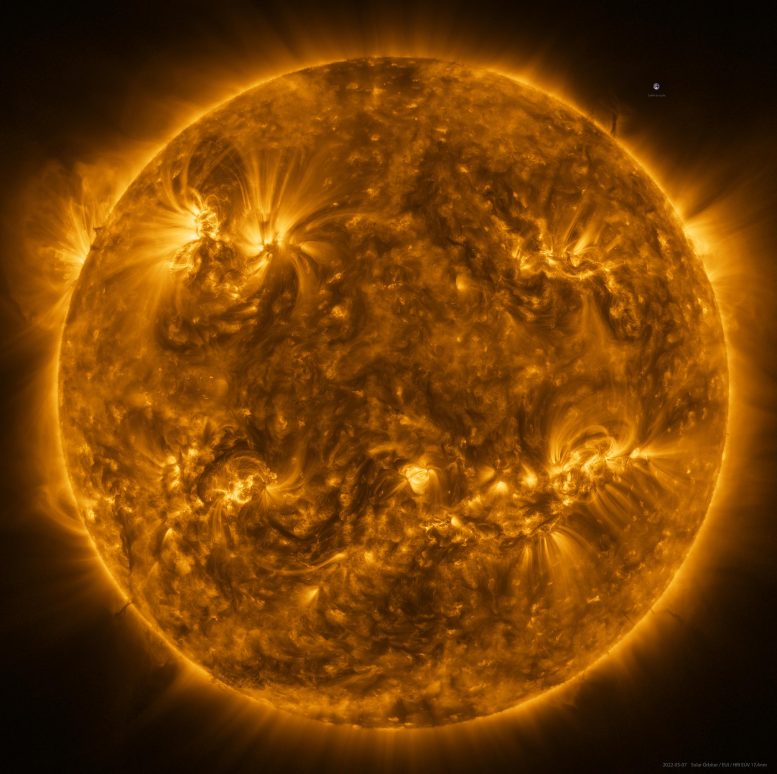
De zon zoals gezien door de Solar Orbiter in extreem ultraviolet licht vanaf een afstand van ongeveer 75 miljoen km. De afbeelding is een mozaïek van 25 afzonderlijke afbeeldingen die op 7 maart 2022 zijn gemaakt door de Ultraviolet Imaging Instrument (EUI) High Resolution Telescope. Deze opname is gemaakt bij een golflengte van 17 nanometer, in het extreem ultraviolette gebied van het elektromagnetische spectrum, en onthult de bovenste atmosfeer van de zon, de corona, die een temperatuur heeft van ongeveer een miljoen graden Celsius. Een afbeelding van de aarde van de schaal op de 2 uur-positie is ook inbegrepen.Credit: ESA en NASA/Solar Orbiter/EUI Team; Gegevensverwerking: E. Kraaikamp (ROB)
In totaal is de uiteindelijke afbeelding Het bevat meer dan 83 miljoen pixels in een raster van 9148 x 9112 pixels. Ter vergelijking: dit beeld heeft een resolutie die tien keer beter is dan wat een 4K-tv-scherm kan weergeven.
EUI beeldt de zon af op een golflengte van 17 nanometer, in het extreem ultraviolette gebied van het elektromagnetische spectrum. Dit onthult de bovenste atmosfeer van de zon, de corona, die een temperatuur heeft van ongeveer een miljoen graden[{” attribute=””>Celsius.
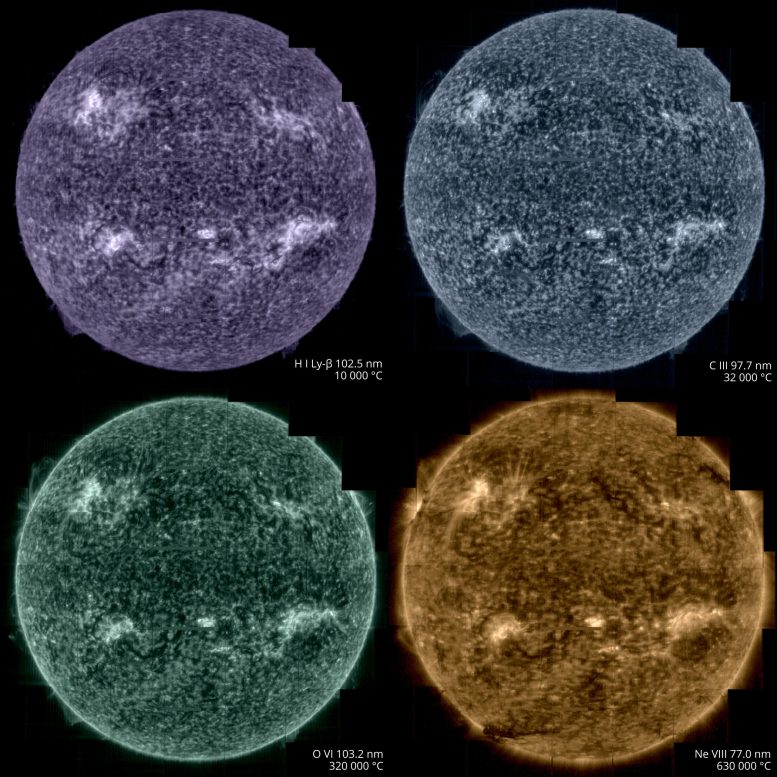
Solar Orbiter took images of the Sun on March 7, from a distance of roughly 75 million kilometres, using its Spectral Imaging of the Coronal Environment (SPICE) instrument. SPICE takes simultaneous “spectral images” at several different wavelengths of the extreme ultraviolet spectrum by scanning its spectrometer slit across a region on the Sun. The different wavelengths recorded correspond to different layers in the Sun’s lower atmosphere. Purple corresponds to hydrogen gas at a temperature of 10,000°C, blue to carbon at 32,000°C, green to oxygen at 320,000°C, yellow to neon at 630,000°C. Each full-Sun image is made up of a mosaic of 25 individual scans. It represents the best full Sun image taken at the Lyman beta wavelength of ultraviolet light that is emitted by hydrogen gas. Credit: ESA & NASA/Solar Orbiter/SPICE team; Data processing: G. Pelouze (IAS)
At the 2 o’clock (near the image of the Earth for scale) and 8 o’clock positions on the edges of the Sun, dark filaments can be seen projecting away from the surface. These ‘prominences’ are prone to erupt, throwing huge quantities of coronal gas into space and creating ‘space weather’ storms.
In addition to EUI, the SPICE instrument was also recording data during the crossing. These too needed to be pieced together as a mosaic.
SPICE is designed to trace the layers in the Sun’s atmosphere from the corona, down to a layer known as the chromosphere, getting closer to the surface. The instrument does this by looking at the different wavelengths of extreme ultraviolet light that come from different atoms.
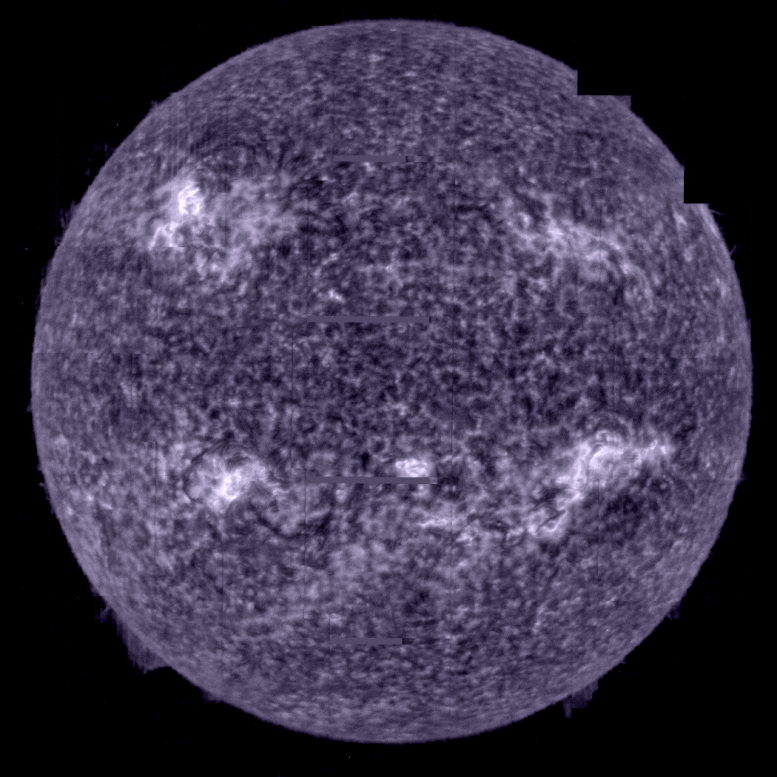
Taking the Sun’s temperature. Credit: ESA & NASA/Solar Orbiter/SPICE team; Data processing: G. Pelouze (IAS)
In the SPICE sequence of images purple corresponds to hydrogen gas at a temperature of 10,000°C, blue to carbon at 32,000°C, green to oxygen at 320,000°C, yellow to neon at 630,000°C.
This will allow solar physicists to trace the extraordinarily powerful eruptions that take place in the corona down through the lower atmospheric layers. It will also allow them to study one of the most puzzling observations about the Sun: how the temperature is rising through the ascending atmospheric layers.
Usually the temperature drops as you move away from a hot object. But above the Sun, the corona reaches a million degrees Celsius whereas the surface is only about 5000°C. Investigating this mystery is one of the key scientific objectives of Solar Orbiter.
The images were taken on 7 March, precisely when Solar Orbiter crossed the Sun-Earth line, so the images can be compared with Earth-bound solar instruments and cross-calibrated. This will make it easier to compare results from different instruments and observatories in future.
On March 26, Solar Orbiter reaches another mission milestone: its first close perihelion. The spacecraft is now inside the orbit of Mercury, the inner planet, taking the highest resolution images of the Sun it can take. It is also recording data on the solar wind of particles that flows outwards from the Sun.
And this is just the start, over the coming years the spacecraft will repeatedly fly this close to the Sun. It will also gradually raise its orientation to view the Sun’s previously unobserved polar regions.
Solar Orbiter is a space mission of international collaboration between ESA and NASA.

“Amateur-organisator. Wannabe-bierevangelist. Algemene webfan. Gecertificeerde internetninja. Fanatieke lezer.”





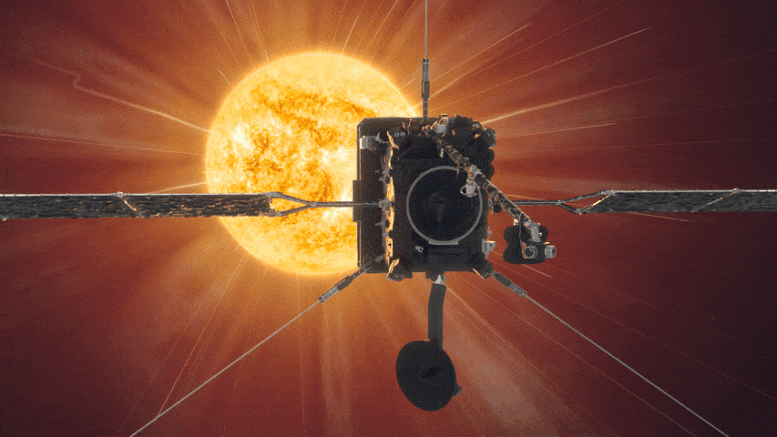
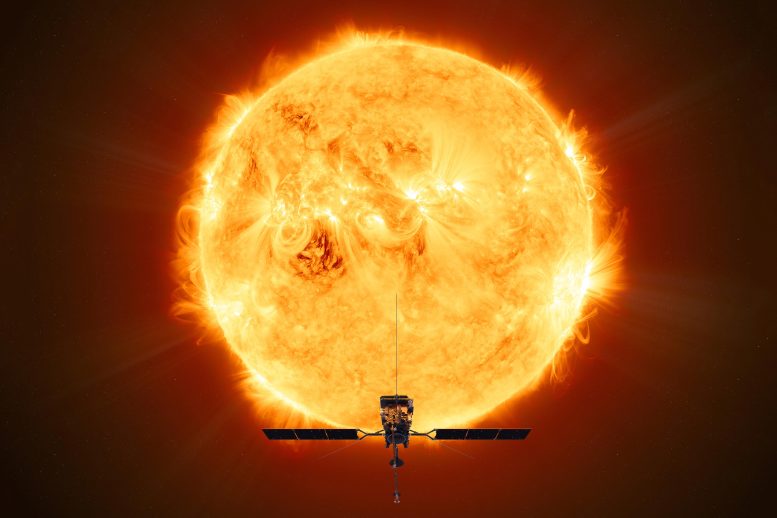


More Stories
Mogelijk draait er een extra maan rond de aarde, en wetenschappers denken dat ze precies weten waar die vandaan komt
Een baanbrekend nieuw principe – Koreaanse onderzoekers hebben een revolutionair fenomeen ontdekt in vloeibare kristallen
Snelle beeldvorming en kunstmatige intelligentie helpen ons te begrijpen hoe insectenvleugels werken